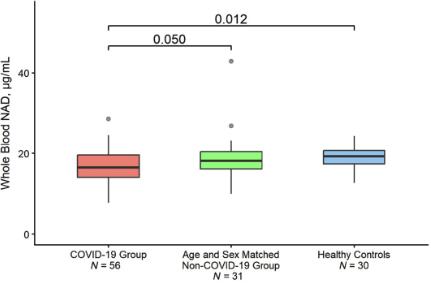This study examined the connection between NAD+ levels, its metabolites, and the severity of COVID-19 in hospitalized patients.
Key Points:
- Whole blood NAD+ levels were only slightly, but significantly, lower in COVID-19 patients
- NAD+ levels in PBMCs were not different between groups
- NAD+ metabolites were higher, indicating increased NAD+ turnover
- The levels of 2-PY, not NAD+, were associated with worse outcomes
Study Evaluates Relationship Between NAD+ and COVID-19 Severity
NAD+ and its metabolites were measured in COVID-19 patients and in two control groups:
- Hospitalized patients with COVID-19 (n=56)
- Healthy controls (n=30)
- Sex- and age-matched controls with conditions commonly observed with COVID-19 patients (n=31)
COVID-19 Patients Had Slightly Lower NAD+ Levels
Whole blood NAD+ levels were only modestly lower in COVID-19 patients compared to both control groups
NAD+ levels in immune cells separated from whole blood (PBMCs, peripheral blood mononuclear cells) showed no significant differences between groups.

This figure shows that whole blood NAD+ levels in COVID-19 patients (red box) were only slightly, but significantly, lower than in non-COVID patients with similar health conditions (green box) and healthy controls (blue box).
Increased NAD+ Turnover Observed in COVID-19 Patients
NAD+ metabolite levels, including 1-methylnicotinamide and nicotinamide, were significantly higher in COVID-19 patients, indicating increased NAD+ turnover.
Gene analysis also showed an increase in pathways related to NAD+ metabolism, inflammation, and immune response.
“The substantially higher concentrations of NAD+ metabolites—1-methylnicotinamide and nicotinamide—in patients with COVID-19 provide corroboration of the increased NAD+ turnover and reduced efficiency at recycling NAM…”
NAD+ Metabolite, 2-PY, Linked to Worse Outcomes
Neither whole blood nor PBMC NAD+ levels were linked to inflammation markers, mortality, ICU transfer, or length of stay.
However, the levels of a metabolite of NAD+ (2-PY) levels were significantly associated with increased risk of death and ICU transfer.
“In contrast to NAD+, circulating levels of 2-PY were significantly associated with the risk of death and worsening clinical status indicated by transfer to ICU.”
Why These Findings are Important
This study found that NAD+ levels were only modestly lower in COVID-19 patients, contrary to the previous assumption that NAD+ is significantly depleted in severe illnesses like COVID-19.
“Overall, we did not find that NAD+ depletion was a contributor to the severity or outcomes of COVID-19 or major age-related differences in the levels of NAD+, as has been reported previously.”
Instead, there was increased NAD+ turnover, as shown by higher levels of NAD+ metabolites.
“The concept that NAD+ is greatly depleted during acute SARS-CoV-2 infections seems simplistic; instead, modest reductions in blood NAD+ levels are accompanied by increased turnover.”
This suggests that higher doses of NAD+ precursors might be needed during acute infections.
“In light of the increased turnover during the acute SARS-CoV-2 infection, it is possible that higher doses of NAD+ precursors may be needed to increase NAD+ levels in people with acute SARS-CoV-2 infection.”
Conclusion
NAD+ levels were only slightly lower in COVID-19 patients compared to controls, but NAD+ metabolites (1-methylnicotinamide and nicotinamide) were significantly higher.
“Our data in patients with SARS-CoV-2 infection show that blood NAD+ concentrations are only modestly lower but that the circulating concentrations of NAD+ metabolites are increased substantially suggesting increased turnover.”
Plasma levels of 2-methyl-2-pyridone-5-carboxamide (2-PY), a byproduct of NAD+ metabolism, were linked to a higher risk of death and the need for more intensive care in COVID-19 patients.
“Plasma concentrations of 2-methyl-2-pyridone-5-carboxamide (2-PY), but not NAD+, were significantly associated with increased risk of death and escalation in level of care.”
The findings suggest NAD+ turnover is elevated in COVID-19, supporting the potential benefit of NAD+ supplementation to reduce disease severity.
“NAD+ turnover is substantially increased with upregulation of genes involved in both NAD+ biosynthesis and degradation, supporting the rationale for NAD+ augmentation to attenuate disease severity.”
